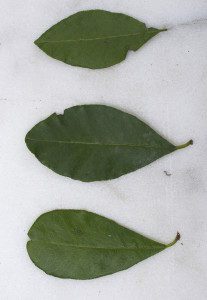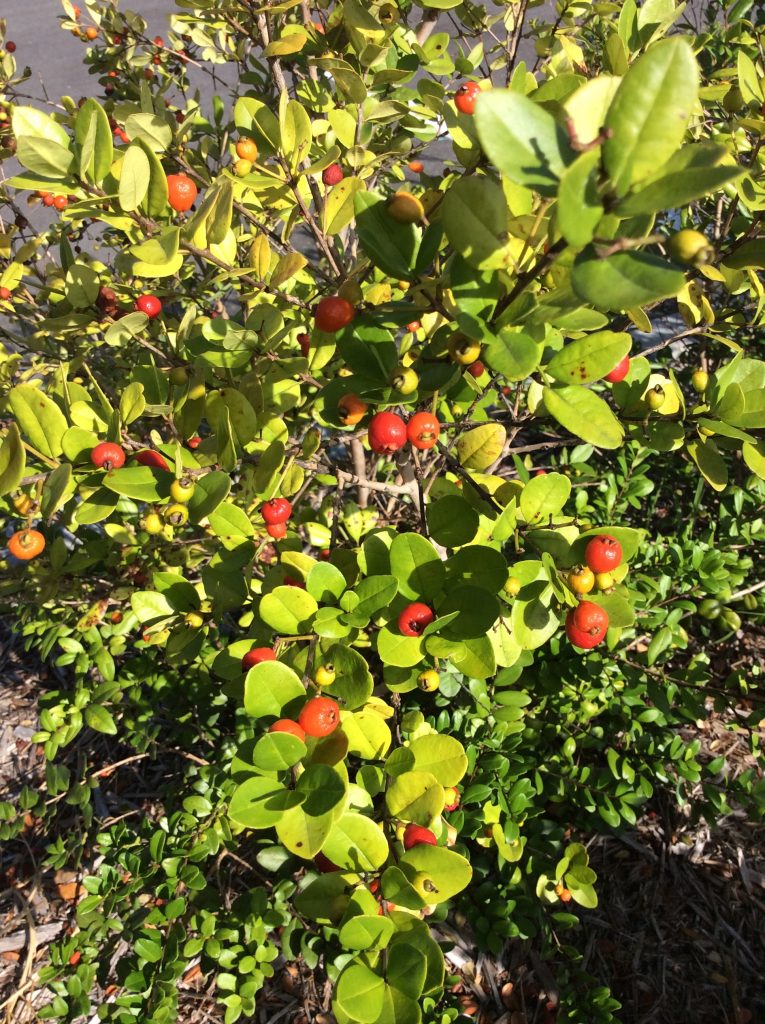
The orange and red fruit of the Simpson Stopper. Photos by Green Deane
Myrcianthes fragrans: Nakedwood Twinberry
I took me about a year to know the Simpson Stopper.
While most people think of Florida as flat there’s actually is a ridge down the middle of the state reportedly from dune fields created in the Pliocene Age, 2.5 to 5.3 million years ago. If you ever drive Interstate 4 from Daytona Beach to Tampa at Lakeland the highway drops over 100 feet down an ancient ocean escarpment, dramatically marking an end to a portion of the ridge. It’s flat from there southwest to Tampa, once ocean bottom.
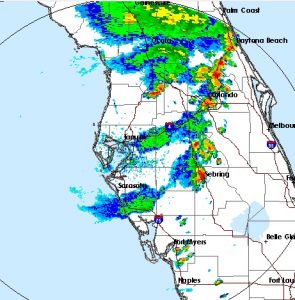
There more between Daytona Beach and Tampa than Interstate 4. It’s a limestone ridge that crosses and also drops down from the middle towards Sebring. The geographical difference engenders thunder storms.
Several species grow across the flat southern end of Florida and up both sides but not in the higher middle, which tends to be a few degrees cooler in the winter. That is the case with the Simpson Stopper aka Myrcianthes fragrans (mer-see-ANTH-eez FRAY-granz) which is hardy down to 25° F, perhaps into the teens if well-established. Inland it grows to just north of Lake Okeechobee, then reaches its botanical arms north along the west coast to Tampa and St. Augustine on the east coast but not naturally up the middle of the state.
I first saw it in at the southern end of the state in Dreher Park, West Palm Beach. It was a small tree. The next time was near the manatee viewing area at Haul Over Canal near the space center, some 200 miles north, a small tree that from a distance could be mistaken for a holly. Both Stoppers were intentionally planted but in south Florida and the islands also grows wild.
I did not find the artificial mother load of Simpson Stoppers but one of my foraging students did. He asked me to visit a local Wholefood’s store in Orlando to look at the landscaping around the shopping center. He said there was a plant there he couldn’t identify. I found a quarter-mile long hedge of Simpson Stopper, in fruit.
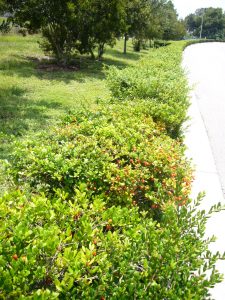
It’s becoming a popular hedge plant.
M. fragrans is in the eucalyptus family. If you crush a leaf it does not smell of eucalyptus but rather citrusy, some think nutmeg, some think a piney citrus aroma. The blossoms are pleasantly fragrant, which helps you identify it from an unpleasant smelling relative, the Spanish Stopper. The sweet, mealy pulp of the red, ripe fruit is edible, but not the seeds as far as I know. Besides, they taste bad. That I do know. The genus is closely related to Guavas as well as Syzigums and Eugenias, In the past many species were moved in and out of these genera and at one time M. fragrans was Eugenia simpsonii. In fact, the particular plant has had some 27 genus or species name changes. E. simpsonii honored Charles Torrey Simpson, a naturalist and author in Miami in the early 1900’s.
Not only are there several “Stoppers” as they are called, but the aforementioned genera also look similar, whether in Florida or Australia. They are generally shrubs to small trees, with leaves about one to two inches long and a half inch to an inch wide. Some have rounded leaves, some have pointed leaves, some are notched. The fruit varies from a black berry to a tiny deep red berry that looks like a pumpkin (the Surinam Cherry.) Some have one or two seeds, others like the Strawberry Guava have many seeds. The fruit tastes like mild orange peeling. They can be small bushy to tall and leggy. In landscaping they are an accent species as well as good hedge material.
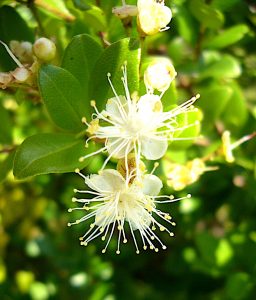
The blossoms are frilly.
There are several identifying characteristics of the Simpson Stopper. Let’s start with the little ones. The orange to red fruit is often in pairs and has a little four-sided round pucker at the end (kind of like a little folded-in blueberry crown made of four triangles.) The closely related Syzigums have a wrinkled cross at the end of the fruit. The leaf of the M. fragrans is also covered with dots. Under a #10 loop the upper surface of the leaf looks like it is covered with tiny drops of water (the dots.) The underside of the leaf is often decked out in what appears to be very tiny green dots, sometimes blackish dots. If you hold the leaf to the light and use a loop you will see gold dots. The leaves can also curl under at the edge. The fruit has one or two bean-shaped seeds, two being more common, often stuck together. They are one of the favored foods of Cardinals and the Mocking Bird, which is Florida’s state bird. The sweet blossoms attract butterflies.
Also called “nakedwood” because of its smooth bark, it is often planted for its leggy multi-trunk wild growth pattern. Botanically Myrcianthes fragrans means “many thorns fragrant.” In this case the “many thorns” refers to the many stamens of the flower, which is also quite fragrant.
Other “stoppers” you might come across include the rare Eugenia confusa (Redberry Stopper), the Eugenia rhomea (Redberry Stopper) whose new growth is pale red while old growth has tiny black dots on the underside of the leaves; Eugenia foetida (Redberry Stopper) whose leaves and flowers smell foul; and the White Stopper, Eugenia axillaris so called because it has light-colored bark, edible mealy fruit.
Green Deane’s “Itemized” Plant Profile
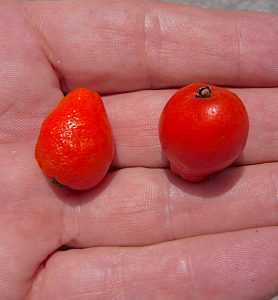
The berries can reach good size. Don’t eat the seed.
IDENTIFICATION: A tree to 55 feet, and 14 inches through, inner reddish brown bark, flaking, growth similar to a crape myrtle, twigs slender, brown, finely hair. Leaves to two inches long, an inch wide, opposite, finely hairy petioles, blunt or rounded at the end, sometimes notched, sometimes pointed, minute gland dots, upper surface shiny dark green, under light dull green. Flowers in clusters, many spreading white stamens, see right.
TIME OF YEAR: Can fruit and flower year round, but favors August and September.
ENVIRONMENT: Full sun to partial shade, likes to be irrigated, hardy to 25F, found often growing over limestone, shell or marl.
METHOD OF PREPARATION: Pulp of ripe fruit is edible out of hand. The texture is soft and mealy. Fruit and bark are rumored to treat diarrhea when made into a tea but I’ve found no modern reference to support that.

